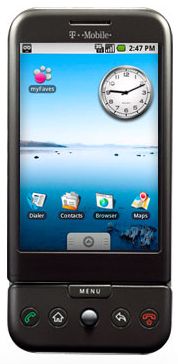G1: Google gPhone and Android hit the market
 The Android platform is a software stack for mobile devices including an operating system, middleware and key applications. Developers can create applications for the platform using the Android SDK.
The Android platform is a software stack for mobile devices including an operating system, middleware and key applications. Developers can create applications for the platform using the Android SDK.
Android is Google’s attempt to dominate the mobile advertising market, just as it has dominated the online PC advertising market, said Craig Wigginton, industry leader for Deloitte’s telecommunications practice. “Their number-one driver for pushing this is the advertising model,” he said.
The G1, the first Android phone introduced by T-Mobile, Google, and HTC on Tuesday, comes loaded with Google applications, including Gmail, Gtalk, Maps, and YouTube. The home screen includes just one item: a Google search bar. Each of those applications is an opportunity for Google to deliver advertisements to users.
There are 3.5 billion mobile-phone users worldwide; many more than computers users. Google, with their success at delivering advertising to desktop computers are looking to monetize this enormous opportunity.
Mobile advertising so far is a small market, but some analysts have high hopes for growth in the future. M:Metrics found that mobile display advertising was an approximately $200 million industry last year, a figure analysts there expect to at least double this year. Analysts at Heavy Reading predict that the mobile advertising industry will exceed $10 billion in annual revenue in 2013.
AdMob is the world’s largest mobile advertising marketplace. Founded in 2006, AdMob allows advertisers to reach their customers on the mobile Web and publishers to increase the value of their mobile sites. AdMob offers both advertisers and publishers the ability to target and personalize advertising to their customers in 150 countries. AdMob has servers over 43 trillion impressions to date, and I’ve seen quite a few on my iPhone, on my sportacular app where I follow up to the minute football games and stats. Researchers at Strategy Analytics predict that 400,000 people will buy the G1 by the end of the year, compared to 1,000,000 people who bought the 3G iPhone on its opening weekend.
Google and T-Mobile appear to be mainly hoping that mass-market consumers will buy the phone, even though smartphones have traditionally appealed most to business users. The G1 lacks some features that business users might want. For example, it doesn’t support Exchange mail, however Android is an open platform and developers can build applications that might interest enterprise users. I think the main difference between Android and the iPhone is the application publication model, since Android developers don’t have to go through Apple Store approval hell.
Once other Android phones start appearing, the platform could gain momentum. “There will be more to come in 2009 when manufacturers such as Samsung and LG will deliver their devices. Android has the potential to become the de facto operating system for Linux, and we expect sales to reach around 10 percent of the smartphone market in 2011,” said Gartner analyst Roberta Cozza.